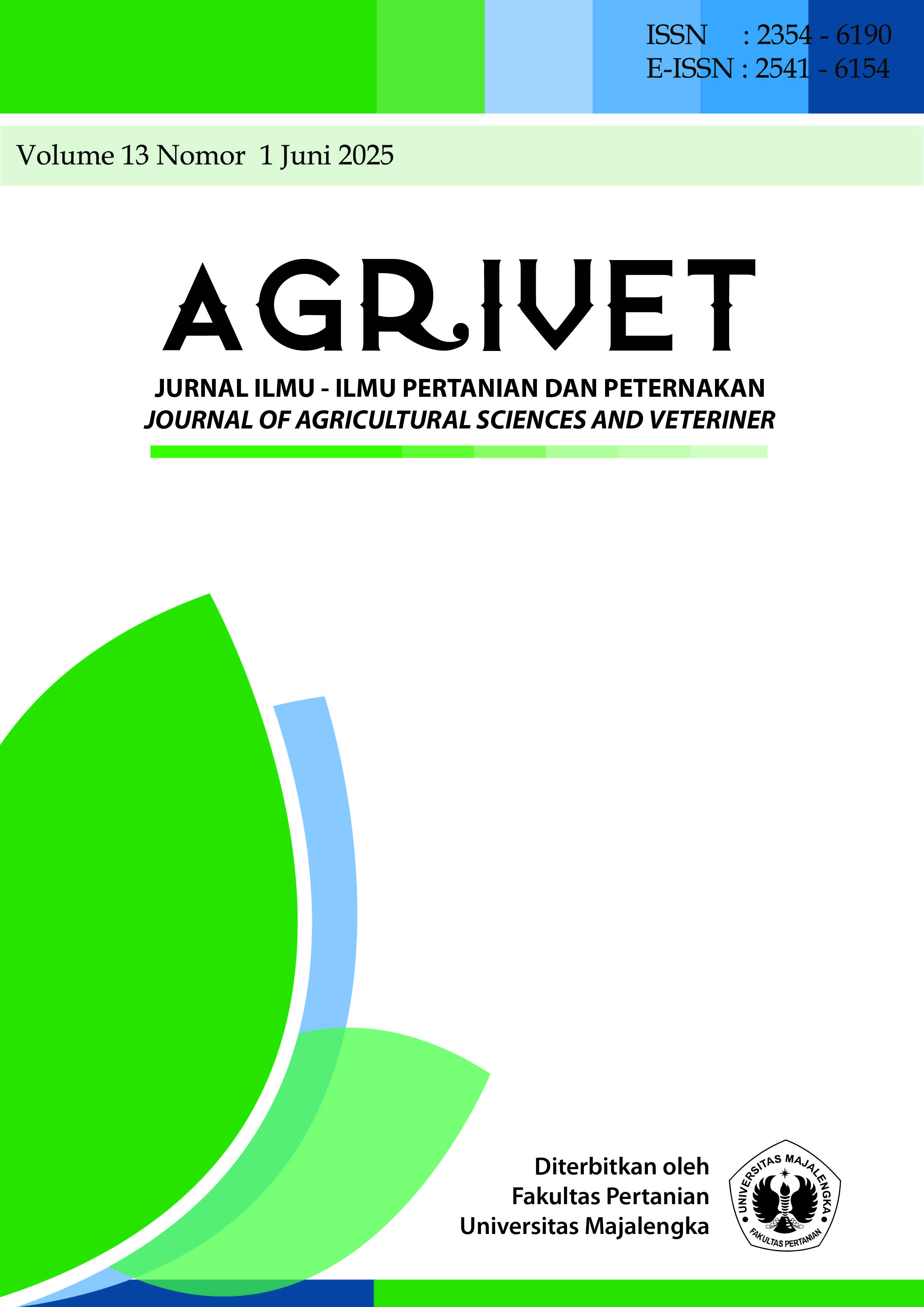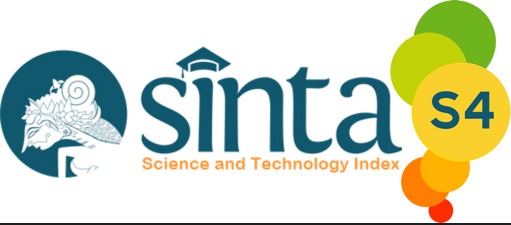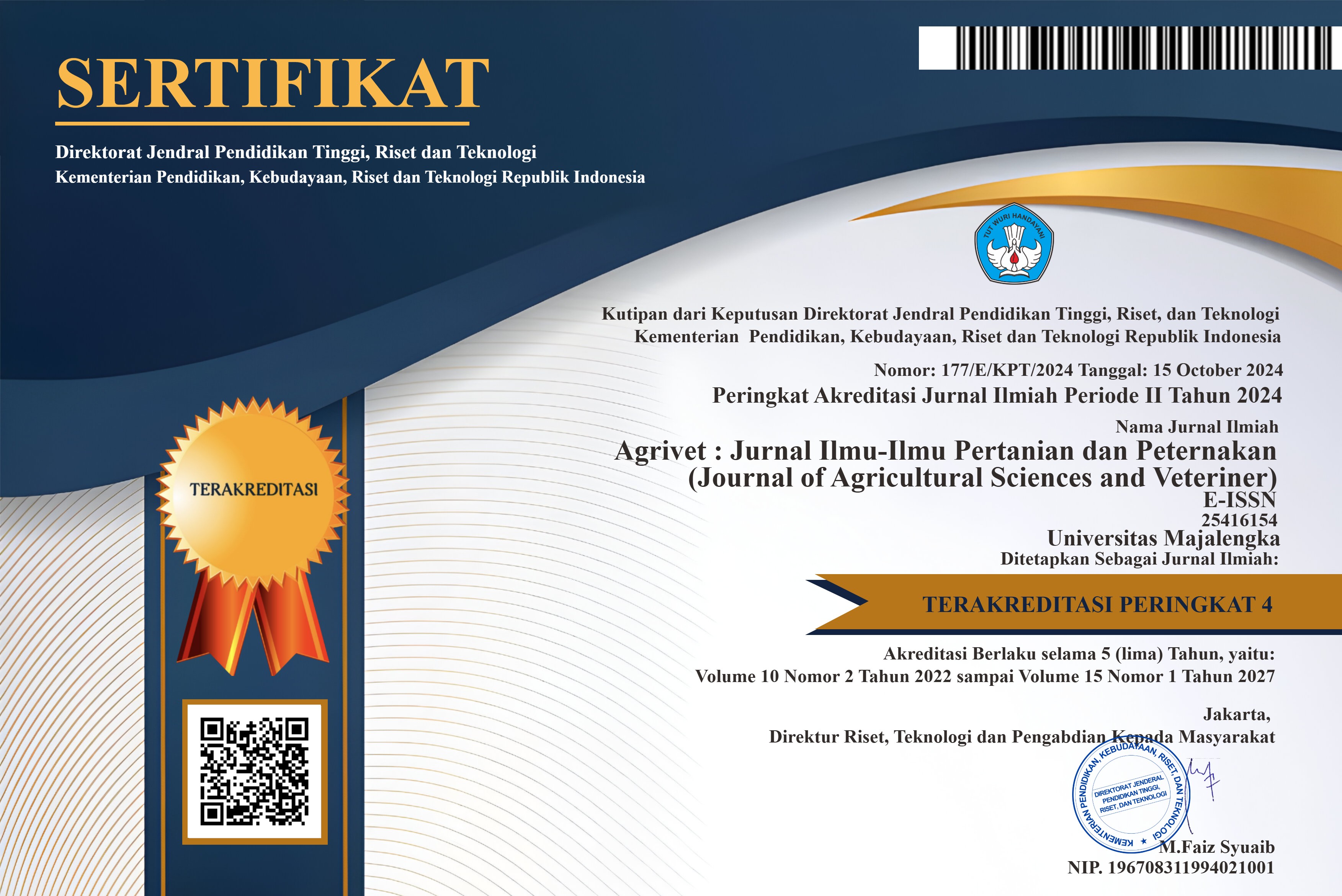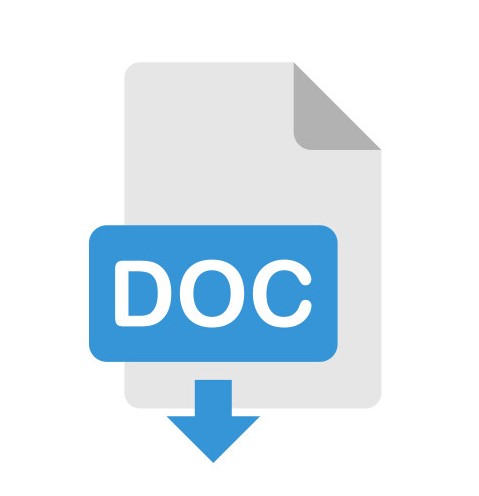Potential and Supportability of Forage in Majalengka Regency for Sheep Farming
DOI:
https://doi.org/10.31949/agrivet.v13i1.13603Abstract
This study aims to identify the potential of forage production and analyze its carrying capacity for the development of sheep farming in Majalengka Regency. The study was conducted through the identification of dominant types of forage fodder, as well as measurement of forage biomass production per hectare of data obtained from secondary data available from the Central Bureau of Statistics (BPS) of Majalengka Regency. The method used is quantitative descriptive method and then the data obtained is analyzed to calculate the carrying capacity of the land based on the need for dry matter (BK) per sheep per year. The results showed that the Majalengka Regency area has a fairly high diversity of forage species, with the potential for forage biomass production reaching an average of 20-25 tons of fresh material/ha/year or equivalent to 4-5 tons of BK/ha/year. Assuming the consumption needs of sheep are around 1.5 kg BK/day, then each hectare of land can support around 7-9 sheep per year. This finding shows that Majalengka has the potential carrying capacity of natural forage and agricultural waste of rice and corn straw to support the sustainable development of sheep farming. Some sub-districts that fall into this category include Maja (3.35), Bantarujeg (3.13), Kertajati (2.43) and Majalengka (2.09). This high index value indicates that the region has great potential to become a center for sheep farming development, because feed is available in sufficient or even excess quantities. Sheep farming centers in 2024 still focus on areas including Sindang (2.44), Banjaran (2.20), Panyingkiran (1.88), Argapura (1.56), and Cigasong (1.36). The high LQ reflects that the livestock sector is one of the main focuses of the economy in the region despite the low feed carrying capacity. Optimizing forage utilization requires sustainable feed management such as the creation of a central feed warehouse located in two different places, namely in kertajati, Bantarujeg and maja for feed buffering in the central sheep cattle area so that it can be integrated with the smallholder farming system
Keywords:
carrying capacity, forage, sheep, Majalengka, sustainable livestock farmingDownloads
References
Annurrofiq, R. F., Widjayanti, F. N., & Fauzi, N. F. (2023). Strategi Pengembangan dan Pemasaran Ternak Domba di Kecamatan Bangsalsari Kabupaten Jember (Studi Kasus Pada Najah Farm). Agri Analytics Journal, 1(2), 17-23
Asriana, R., Daru, T. P., & Ardhani, F. (2021). Potensi hijauan pakan pada perkebunan kelapa sawit milik rakyat di Kecamatan Samarida Utara, Kota Samarinda Kalimantan Timur. Jurnal Peternakan Lingkungan Tropis, 4(1), 54-58.
Badan Pusat Statistik Kabupaten Majalengka, (2025). Kabupaten Majalengka dalam angka 2025..https://majalengkakab.bps.go.id/id/publication/2025/02/28/0f6c36c9e7b1da98f1e9a70c/kabupaten-majalengka-dalam-angka-2025.html
Dotulong, L. C., Kaunang, C. L., Tuturoong, R. A. V., & Waani, M. R. (2021). Daya dukung dan indeks daya dukung hijauan alami di bawah perkebunan kelapa sebagai pakan ternak sapi di Kecamatan Airmadidi. Zootec, 41(2), 398-404.
Lima, D., & Patty, C. W. (2021). Potensi limbah pertanian tanaman pangan sebagai pakan ternak rominasia di Kecamatan Waelatakabupaten Buru. Agrinimal Jurnal Ilmu Ternak dan Tanaman, 9(1), 36-43.
Muller, Z. O. (1974). Livestock Nutrition in Indonesia. UNDP, FAO, Rome, Italy.
Munardi, M., Nur, M. M., Fuadi, F. I., Hasan, N., & Firdaus, R. (2023). Determinan Praktik Mawah Terhadap Pendapatan Ekonomi Keluarga Peternak Di Kecamatan Simpang Keuramat Kabupaten Aceh Utara. El-Amwal. https://doi.org/10.29103/el-amwal.v6i1.10508
NRC. (2007). Nutrient Requirements of Small Ruminants: Sheep, Goats, Cervids, and New World Camelids (6th ed.). The National Academies Press, Washington, DC. https://nap.nationalacademies.org/catalog/11654/nutrient-requirements-of-small-ruminants-sheep-goats-cervids-and-new
Ornelas.V, E. C., Navarrete-Molina, C., Meza-Herrera, C., Herrera-Machuca, M. A., Altamirano-Cárdenas, J., Macías-Cruz, U., García-De la Peña, C., & Véliz-Deras, F. G. (2022). Sheep production and sustainability in Latin America & the Caribbean: A combined productive, socio-economic & ecological footprint approach. Small Ruminant Research. https://doi.org/10.1016/j.smallrumres.2022.106675
Surachman, M. A., Mulatsih, S., & Rindayati, W. (2022). Analisis Perwilayahan Usaha Ternak Domba di Provinsi Jawa Barat. Jurnal Tataloka, 24(3), 257–266. https://doi.org/10.14710/tataloka.24.3.257-266
Tanuwiria, H., Yulianti, A., & Mayasari, D. N. (2006). Potensi Pakan Asal Limbah Tanaman Pangan dan Daya Dukungnya terhadap Populasi Ternak Ruminansia di Wilayah Sumedang. Jurnal Ilmu Ternak.6 (2), 112 – 120
Wang, L., & Tan, H. (2022). Economic Analysis of Animal Husbandry Based on System Dynamics. Computational Intelligence and Neuroscience. https://doi.org/10.1155/2022/5641384
Wenno, A., Patty, C. H., & Eoh, M. (2023). Daya dukung dan indeks daya dukung hijauan alami di areal perkebunan kelapa dalam sebagai pakan ternak ruminansia di Kecamatan Taniwel Kabupaten Seram Bagian Barat. BIOPENDIX: Jurnal Biologi, Pendidikan dan Terapan, 10(1), 110-116.
Published
How to Cite
Issue
Section
License
Copyright (c) 2025 Itang Purnama, Dini Widianingrum

This work is licensed under a Creative Commons Attribution-ShareAlike 4.0 International License.
An author who publishes in the Jurnal Agrivet agrees to the following terms:
- Author retains the copyright and grants the journal the right of first publication of the work simultaneously licensed under the Creative Commons Attribution-ShareAlike 4.0 License that allows others to share the work with an acknowledgment of the work's authorship and initial publication in this journal
- The author is able to enter into separate, additional contractual arrangements for the non-exclusive distribution of the journal's published version of the work (e.g., post it to an institutional repository or publish it in a book) with the acknowledgment of its initial publication in this journal.
- The author is permitted and encouraged to post his/her work online (e.g., in institutional repositories or on their website) prior to and during the submission process, as it can lead to productive exchanges, as well as earlier and greater citation of the published work












